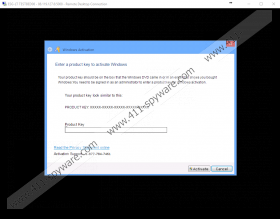Fake Activation Support 1-877-784-7461 Removal Guide
Fake Activation Support 1-877-784-7461 is a new technical support scam based on a fake alert. This infection blocks your screen and locks your executable programs so your computer becomes inoperational. Even if you try to restart your system, the fake Windows Activation window will show up again and again. Do not think for a second that if you enter your real product key and press “Activate,” your situation gets any better. As a matter of fact, this is all about making you have to call the provided alleged Activation Support telephone number (1-877-784-7461). But we advise you not to do that. In fact, we recommend that you remove Fake Activation Support 1-877-784-7461 fake alert infection the moment you find out that it has attacked your system. If you want to learn how you can eliminate this malware threat from your computer, please read on.
Based on our research we can say that this fake alert mainly spreads through spam e-mails as an attached file. This attachment can usually be a text document with a malicious macro code, an image, or a video file. But in reality this is an executable file that only poses as an image or text file using fake icons. Unsuspecting computer users may not realize that the file name may hold a clue, for example, “invoice20160203.docx.exe.” You should be very careful with your inbox because spams can trick your filter and end up there waiting for you to take the bait. The criminals behind such an attack are usually a creative lot who can easily deceive you to want to open the malicious mail. First of all, they use an eye-catching subject, such as “Unpaid Invoice No. 20160203id123,” “Credit Card Error,” “Mail Delivery Error,” and the like. They can use any topic really that would immediately draw your attention and make you open it and download the attached file.
In most cases it is not even the worst thing that you open such a mail and download the attachment. The worst you can do is to open or run this file because it is indeed how you initiate this attack. The lesson here is quite clear: Do not open suspicious mails coming from unfamiliar senders and do not download attachments that you are not expecting to receive. Once you run the attachment, there is only one way to keep your system protected: You need to delete Fake Activation Support 1-877-784-7461 right away.
We have discovered that this fake alert is very similar to other technical support scams that have hit the web recently, including “Windows Security Alert! 1-888-220-3607” and “Windows Support. Call TollFree: +1 -855-441-4421.” This malware infection, once activated, makes sure that it automatically starts up with Windows every time you restart your computer. This is why you cannot get rid of it easily, unless you remove it from your system. When it finishes the setup, a fake Windows activation window blocks your whole screen on black background. But it is not only your screen that is blocked; as a matter of fact, this infection also blocks your .exe files from running, including your browsers. This means that you have seemingly no choice but either to enter the product key in the provided box or to call the supposed Activation Support telephone number, 1-877-784-7461. Since this is really a scam, do not expect miracles from entering your code and clicking on the “Activate” button. In fact, nothing happens if you do so, which seemingly leaves you with one single option: to call the number.
We are here to warn you not to call this number, though, because you could be scammed out of your money. Such a scam is mainly about trying to sell you a potentially useless service or software for a non-existent technical or system error. Victims could be tricked to pay from 100 up to 400 USD generally. If you do not want to be tricked in any way, you should not think twice to remove Fake Activation Support 1-877-784-7461.
Since this fake alert blocks your screen and your programs, the only way for you to be able to eliminate it is to restart your system in Safe Mode and then, delete the necessary files and registry entries. If you feel up to this task, please follow our step-by-step guide below. You should know that the infection of your computer can be easily and automatically avoided. Even if you try to be very careful about clicking on third-party ads, avoid visiting suspicious websites and opening suspicious e-mails, there is a chance that you slip up at one point and let a bunch of threats onto your computer. This is why we recommend that you find a reliable anti-malware tool and install it as soon as possible for the best protection you can get against all known malware infections.
Restart your PC in Safe Mode
Windows 8, Windows 8.1, and Windows 10
- On the Metro UI screen, press the Power button.
- Press and hold the Shift key and click Restart.
- Select Advanced options from the Troubleshooting menu.
- Click Startup Settings and select Restart.
- Restart in Safe Mode by pressing the F4 key.
Windows XP, Windows Vista, and Windows 7
- Restart your computer and press F8 when BIOS loads.
- Choose Safe Mode and press the Enter key.
How to remove Fake Activation Support 1-877-784-7461
- Press Win+E.
- Locate the downloaded malicious file and bin it.
- Locate and delete the folder of the executable malicious file: “C:\Windows\Microsoft Excel\Microsoft Excel”
- Empty your Recycle Bin.
- Press Win+R and type regedit. Click OK.
- Remove the "Microsoft Excel" value name from these registry entries:
HKEY_CURRENT_USER\Software\Microsoft\Windows\CurrentVersion\Run
HKEY_LOCAL_MACHINE\Software\Microsoft\Windows\CurrentVersion\Run
HKEY_LOCAL_MACHINE\Wow6432Node\Software\Microsoft\Windows\CurrentVersion\Run (64-bit) - Restart your system in Normal Mode.
Fake Activation Support 1-877-784-7461 Screenshots:


